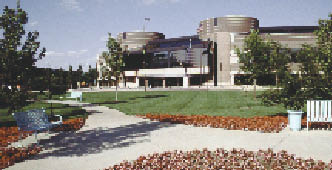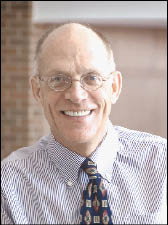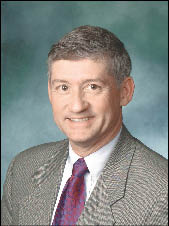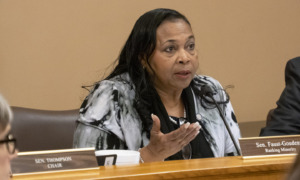 |
Almost eight decades after its founding, the W.K. Kellogg Foundation is embarking on the kind of complex, fundamental overhaul of its mission and process that foundations rarely try – one that will affect every current and would-be grantee, and everyone who works with or for Kellogg.
Over the ensuing months and years, the youth field will watch as this large foundation attempts a course change that is both ambitious and tricky.
Kellogg ($8.4 billion in assets) wants to be “distinct in our effectiveness and impact,” says CEO Sterling Speirn.
The overhaul “will require a real culture change in the foundation,” says one observer who used to run a foundation.
The changes, detailed in an internal plan provided unofficially to Youth Today, include emphasizing civic engagement and racial equity; focusing on younger kids (from third grade down); awarding half of its grants in just three states; and, perhaps most challenging of all, choreographing a complex management matrix in which new teams of staffers will focus on both geographic and subject areas, while developing a “holistic” approach that integrates their work with that of other teams. And they plan to get grants out the door faster.
It appears, however, that the changes will come slowly. The shift in grant-making focus was announced last December, two years after Speirn became foundation president and CEO.
 |
|
Speirn: Seeks to be “distinct in our effectiveness and impact.” Photo: Kellogg Foundation |
Unlike new CEOs who move quickly to remake a foundation to reflect their personas, Speirn’s approach has been methodical, with an eye finely tuned to Kellogg’s original intentions. The new mission and vision statement is to support “children, families and communities as they strengthen and create conditions that propel vulnerable children to achieve success as individuals and as contributors to the larger community and society.”
The foundation made almost $335 million in grants last year; it’s unclear how many of those grants would have been made under the restated mission. Grantees have been told that they won’t be rejected out of hand for renewals, but they will have to re-examine what they are doing to see whether they fit the new vision.
Core Strategies
W.K. Kellogg – whose founding of the Kellogg cereal company in the early 1900s made him one of America’s richest men – was inspired to create his foundation after serving in 1930 as a delegate to the White House Conference on Child Health and Protection, to which he was appointed by President Herbert Hoover. In forming the W.K. Kellogg Child Welfare Foundation, he said, “I want to help those with little or no income. I want to establish a foundation that will help handicapped children everywhere to face the future with confidence, with health, and with a strong-rooted security in their trust of this country and its institutions.”
Kellogg says its new mission and vision statement return to and honor the founder’s commitment. The foundation has laid out three core strategies to carry out that mission:
1. Three-State Focus
Although Kellogg is a national foundation, its new strategy will target about half of its grant dollars to three states: Michigan, Mississippi and New Mexico. Michigan is the foundation’s home state, where much of the nonprofit and children’s infrastructure bears the foundation’s stamp. Kellogg’s home town of Battle Creek has more than 60 active grants; the foundation has more than 120 active grants to other Michigan projects. According to one foundation vice president, Michigan probably will continue to get more than Mississippi and New Mexico.
Kellogg was the largest foundation grant maker to Mississippi in 2006 and is routinely one of about a half dozen philanthropic mainstays in the state. A majority-minority state, New Mexico has ranked 47th or 48th for the past five years in the Annie E. Casey Foundation’s Kids Count rankings of youth well-being, but has not been a major recipient of Kellogg money. Kellogg has 15 active grants to groups in the state, five of them made since the shift in mission. In contrast, the foundation has at least 34 active grants in Mississippi.
2. Success by 3rd Grade
Focusing on children from birth to age 8 is the strategic pivot point in the plan for vulnerable children. The foundation’s internal plan notes that “from the earliest moments of life, the child development clock is ticking. … Because the traditional education system is not set up to meet the diverse learning needs of children, our work will focus on transforming how the traditional school system educates young children.”
3. Holistic Approach
Here’s where things get really complicated.
“What’s new,” Speirn says, “is the connective tissue,” the notion that you can’t address the needs of vulnerable children without addressing issues of family, community and the nation. This holistic strategy encompasses five program areas:
• Family income and assets.
• Community assets.
• Education and learning.
• Food, health and well-being.
• Civic and philanthropic engagement.
Kellogg plans to address each of these areas with “levers of change.” For example, the levers associated with family income and assets include participation in the national policy debate on breaking the cycle of poverty; income- and asset-creation strategies (such as expanded access to the Earned Income Tax Credit); and promotion of Individual Development Accounts (IDAs), including accounts for youth.
Staff teams led by Kellogg vice presidents will focus on understanding, refining and articulating these program elements. Teams also will be devoted to the three target states. The model is a foundation version of the corporate world’s matrix management, a technique based on a cross-functional team approach.
This is a major change for Kellogg. Previously, areas within the foundation operated as silos, with little dialogue among them. The exception was the foundation’s rural programming, which couldn’t be addressed except through tapping in-house knowledge on health, youth, education and economic development.
Not coincidentally, Rick Foster, who headed the rural development program and is now a vice president for programs, leads the team overseeing Michigan and is expected to play a lead role in implementation of the new plan.
New Areas of Emphasis
Foster and his fellow vice presidents are crucial to this process: People inside and outside the foundation say the vice presidents have been instrumental in crafting Kellogg’s new mission and vision, in many ways co-equal to Speirn. Before going to Kellogg, Speirn spent 15 years as president and CEO of California’s Peninsula Community Foundation (assets: $919 million).
|
|
|
Foster: “We can do better if we focus differently and marshal our human resources.” Photo: Kellogg Foundation |
While some longtime Kellogg staff members have been moved around and two new vice presidents have been hired – Anne Mosle from the Washington Area Women’s Foundation and Gail Christopher from the Joint Center for Political Studies – other longtime Kellogg program players are still in their chairs. They include Foster; Jim McHale, senior vice president for programs; and Greg Taylor, a vice president for programs.
Among other things, they will be charged with steering the work of all the teams toward two areas of emphasis:
Civic Engagement
One of the first meetings of potential grantees was convened to talk about innovations in civic engagement. To achieve substantial changes in the conditions of vulnerable kids, says one Kellogg insider, the foundation sees a need for stepped-up support of “civic engagement [as] … the foundation of social change work.”
This should mean more than getting a lot of kids to clean up streams and speak at council meetings. “While we don’t involve ourselves in the political process,” Speirn says, “we do need to speak up more, work through grantees, and take positions and take stands.”
To this end, Kellogg has recruited progressive civic engagement advisers, calling on PolicyLink, based in California, to facilitate the civic engagement session and tapping the Center for Community Change for new perspectives.
Racial equity
The strategy makes racial equity a central function at the foundation. The importance of dealing with race and ethnicity are evident throughout the mission and vision statement, in the public statements about the conditions of vulnerable children, and in the selection of the three target states.
The language of the foundation’s internal plan stands in stark contrast to the puffy commitments of most foundations to the current philanthropic au courant “diversity”:
“The Kellogg Foundation is committed to being an effective anti-racist organization. … Our commitment to anti-racism paves the way for funding work to dismantle structural racism and to heal and reconcile racial attitudes, beliefs, and misunderstandings that constrain the lives and futures of vulnerable children.”
Speed
Kellogg also plans to operate at a much faster pace.
Foundations are notoriously process-oriented, with layers of back-and-forth before decisions are made and money flows. Kellogg’s plan promises speedy action, once the vision is firmly rooted in the various functional teams. Says one staffer charged with promoting the new agenda: “It will take us a lot less time to get a grant out the door.”
A precursor of this change was the foundation’s rapid decision to commit $100 million of the endowment to investments keyed to the new mission. Longtime Kellogg senior staffer Tom Reis made the pitch in the fall of 2007 and received a rapid and enthusiastic response on the spot from the board and Speirn. The effort was launched early this year.
Although not in the same league as the mission-based investment portfolio of the New York-based F.B. Heron Foundation, which invests 25 percent of its endowment in its mission of helping people and communities to help themselves, Speirn characterizes this as “one of the largest mission-related investment funds” in philanthropy. The move enabled Kellogg to put money into Community Development Financial Institutions, community development credit unions and what it calls “social enterprises with double bottom-line investments.”
Challenges
The task of turning a ship as large as Kellogg is tricky and monumental – as well as anxiety-inducing for current grantees, who may not fit easily into the new profile.
Inside and outside of Kellogg, there are concerns about whether the foundation is trying to do too much, too fast. Among the concerns:
Matrix Management
One executive at another foundation said that despite Kellogg’s achievements, its past narrow, programmatic focus has made the foundation “underachievers in … impact.”
Kellogg hopes that having teams to address each of the five program elements and teams to focus on the target states will increase its impact. “We can do better if we focus differently and marshal our human resources to these issues,” says Foster, the Kellogg vice president who leads the Michigan team.
However, creating all these teams that are supposed to integrate their work raises another concern. Outsiders say that while cross-functional teams of matrix management look good on paper, some organizations find themselves tied in knots trying to make decisions with such a system. After all, how many staff and expert perspectives do you need to figure out how the five program elements should be deployed in Michigan vs. New Mexico?
Where to Focus Attention
It is difficult to discern a particular “theory” about vulnerable children in the new strategy. The foundation’s 59-page strategic vision document makes references to statistics about the conditions of poor and minority children, but does not cite the work of noted experts on interventions for children to explain why the third-grade target is more important than, for example, the Gates Foundation’s “thrive by 5” emphasis.
Foster acknowledges that the foundation is “in transition … with a lot of hires yet to happen.” Some of the to-be-recruited experts might alter parts of the foundation’s thinking, or nonprofit grantees on the ground might be able to help fill in some of the weaker areas of the foundation’s strategy.
Moreover, the recommended levers of change do not focus specifically on children. They deal with fundamental community, macroeconomic and societal issues, the “root causes” of poverty and racism. Foster notes that W.K. Kellogg’s experience with his original children’s welfare fund taught him that the best way to address the problems of poor children was “coming back to community … reaching the areas around them.”
Finding and Measuring Success
Can a foundation’s $300 million annual grant-making portfolio really make measurable changes in the lives and prospects of vulnerable children?
One jaundiced observer compares the new Kellogg approach with the programs of the health conversion foundations. Not long after their establishment, those foundations found themselves addressing a jumble of community and economic issues that directly and indirectly affect health, but coming up with measurable changes in health outcomes proved elusive. Kellogg faces a similar challenge in seeing what its grant dollars accomplish for vulnerable kids.
A Cohesive Kellogg Strategy?
The five program elements, the multiple levers of change, the emphasis on success by third grade, the emphasis on racial equity: If you feel a little confused and not sure what the single, core message is, imagine the challenge of carrying it out if you were at Kellogg.
Outsiders see a core challenge in getting the foundation’s more than 200 employees to come to a cogent and consistent understanding of the meaning of a foundation’s complex theory of change touching on children, economics and racism.
What Kellogg has, essentially, is an emerging framework, or what Foster refers to as a “mental model.” The in-house mission and vision plan, subtitled “A Framework for Action,” calls for staff consensus on “a sturdy platform that we can all own, understand, and adopt.”
In addressing the diversity of opinions among foundation employees, Foster says, “We have to get through a foundation mental model about what the foundation believes. … We have to set an expectation in the field so that every time a [Kellogg] person comes, the mental model of the foundation is on that issue.”
Outsiders question whether the foundation will be able to implement five program elements, dozens of levers of change and an array of potential interventions.
Speirn and his colleagues say they don’t need a unique brand or approach. Rather, Speirn says the foundation is talking with and trying to learn from others, like Casey, the Buffett Early Childhood Fund and the United Way of America, with its new focuses on education, income and health.
As always, the mechanics will ultimately matter less than the perception of results. Speirn and his colleagues will have to answer the question: “How did you use the freedom of your billions of dollars, and where did it lead?”
Rick Cohen is former executive director of the National Committee for Responsive Philanthropy and is now national correspondent for Nonprofit Quarterly. Contact: cohenreport@npqmag.org.

























